Collecting the fence for the stairs, it is necessary to decide how to install balusters, racks, support pillars. Everything is not so simple, because the installation of balasine depends on the type of stairs, the material from which the staircase is made and the railing itself. At the same time, more aesthetic preferences are taken into account.
Number of Balyasin and Support Pillars
First of all, it is necessary to decide on that one balaasine will be on the step or two. Acceptable both options. The second point: it is necessary to decide where and with what frequency will be the support pillars. There are several options:
- At the beginning and at the end of the span.
- Through the step.
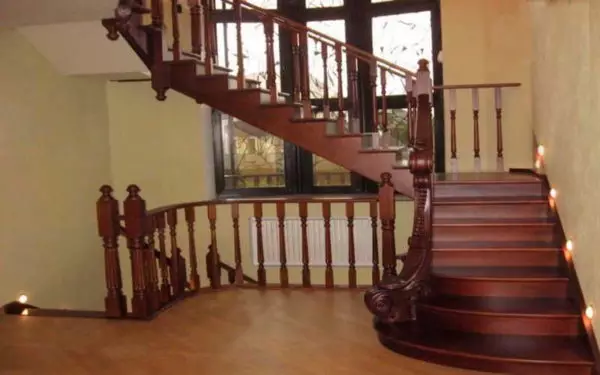
Most often, the reference pillars are located at the beginning and at the end of the staircase
- Two steps.
- Three steps.
A large number of columns on the stairs are necessary if the balusters do thin or filling - not vertical, but longitudinal "threads", which are not loaded, and perform protective and / or decorative functions.
Place marking for pillars and bassine
In any case, all pillars and balusters on the span should stand on one straight line. Moreover, if the radius / size of balaasine / support pillars is different, are set on the same line of their centers. After installing all the balaasine and poles, if you look along the line, all of them must be in the same plane.
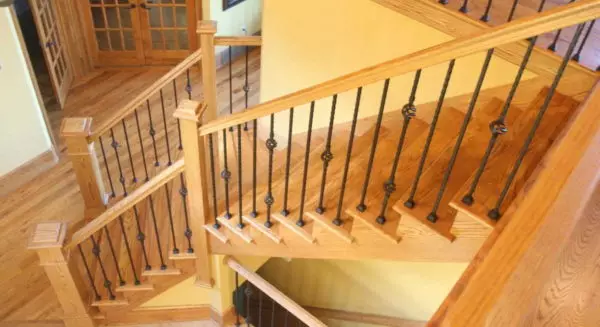
The first stage of installation of the railing - markup of the installation sites of the column and Balyasin
At what distance from the edge of the stage to have balasins
On average, the Balian Center is installed at a distance of 6-10 cm from the edge, but can also have the very edge. Choose as you like. But it is necessary to choose this distance to determine the place where it will be necessary to make holes for the installation of Balyasin.
To determine the distance there is an algorithm. Typically proceed from the fact that the staircase or balassine must be at a distance of 2-5 cm from the side edge of the stage. The size of the pillar or bales is divided into two, add the selected distance to the edge and we obtain the desired value.
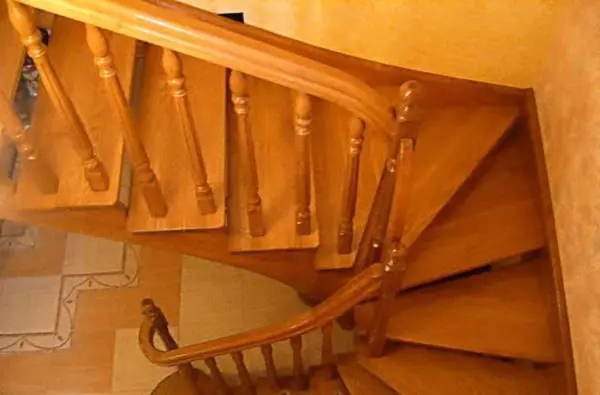
The distance from the edge of the stage is chosen arbitrarily
Let us give an example, calculating the installation site of the baluster. Let them have a square cross section below, 80 * 80 mm. From the edge of the stage, they must be held for 3 cm. Total we get: 8 cm / 2 + 3 cm = 7 cm. That is, when the place of fastening of the baluster on the stairs from the edge of the stage it will be necessary to postpone 7 cm. Also enter if the balusters are round: diameter 7 cm, from the edge - 3 cm. 7 cm / 2 + 3 cm = 6.5 cm. That is, in this case, the hole for mounting the stair balaasine is made at a distance of 6.5 cm from the edge of the stage.
Algorithm Installation Balyasin
The process of marking the Balyasin step by step can be described as follows:
- On the upper and lower stage of the span from the edge of the stage, define a certain distance, which depends on the size of the poles / balasine.
- Between the dots spend directly. You can do it:
- Having / screwed into the planned nails / self-tapping screws, stretching the thread between them;
- exhibiting a line on the laser level;
- Having installed an even bar / guide.
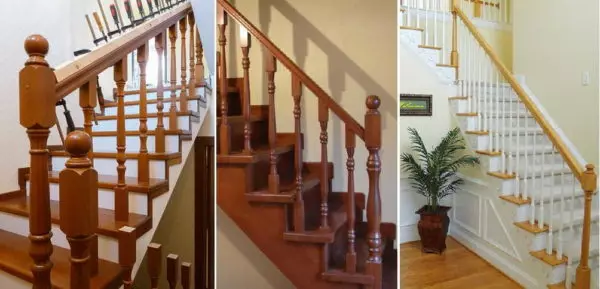
Balaasins can be installed one or two on the step. There is also an option - two on one one, one on the next one, on the third step again two and so on, alternating and alone, then two
- On the steps tolerate straight. It is more convenient to do this with a large carbon and pencil. At each stage, it turns out there is a line for which we will show the centers of the columns and balasine.
- Now it is necessary to place where the stairs are installed. Be sure to stand at the top and bottom of the span. The first put pillars for the ladder below and at the top of the span. Then, locate where the balusters will stand. Watch that the distance between them was the same or almost the same. The permissible difference is 1 cm (for example, between all the balusters, 9 cm is obtained, and between one post and balassine - 8 cm).
The main task of this stage is to transfer directly to the steps as accurately. The second is to choose such a distance between the columns and the balusters so that there is no noticeable eye of the differences. If it is impossible to do everything equally, you can do symmetrically - large or smaller leave distances around the edges or alternate them through one or two. There are no universal solutions, since each staircase is unique, with its parameters and features.
Procedure for assembling Peril
In order for the installation of the railings on the staircase, without surprises, it is necessary to clearly represent the entire process.
- Fasten two extreme columns - at the top and bottom of the span. They are exhibited so that from the edge of the pillar to the edge of the stage was the same distance (usually 3-6 cm). If the staircase is made on a koser, they are setting them by combining the edges, or after being following the same distance from both sides.
- A rope stretches between the two mounted columns. Self-tapping screws are screwed into their center, the twine is tensioned, according to which it will be necessary to set the centers of the balaasine and poles installed, it will be possible to look at the height, etc. Instead of a rope, you can install a guide if you are sure that it does not save anywhere else.
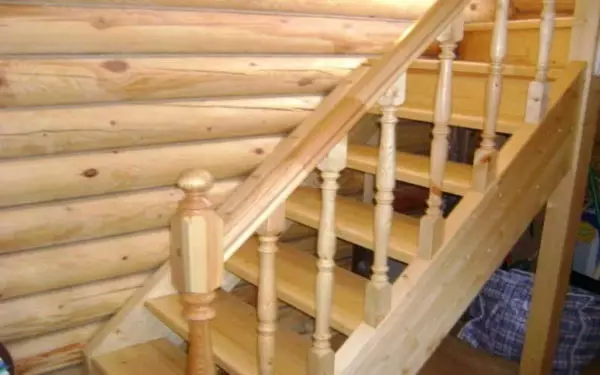
The order of assembly of stair railings consists of several consecutive actions
- Balaasins are fastened, pillars are put on the existing markup. Their position is strictly vertical and so that the top will be in a thread / guide.
- When installing each element, its position is selected:
- Poles / Balasins should stand strictly vertically, without the slightest deviations. It is necessary to check in two planes.
- They should be on the same line with the already installed, "not walk" to the right or left.
- On the posts are put on the railing (with a submeritator or without - depends on your desire).
Next, the process is repeated for the second span. The latter than the installation of the railing ends is to combine the support pillars at the point of rotation. A specific way depends on the type and material of the handrail, but it is necessary to have to be able to make it so that this site be the transition from one span to another, while it was convenient and did not seem alien.
Fastening of wooden balasine and pillars
Many agree that the installation of the railing is harder than the manufacture of the stairs actually: too many different nodes, there are no standard solutions suitable for all. That's the complexity. Perhaps the most difficult to install wooden railing. The material is plastic, but also problems: well-fixed element at first, in a year or two can hang out with a decent amplitude. Therefore, to the attachment of poles and balaasine from the tree is very and very neatly, reinsured, use combined methods, adding glue if possible. So the connections are tougher.
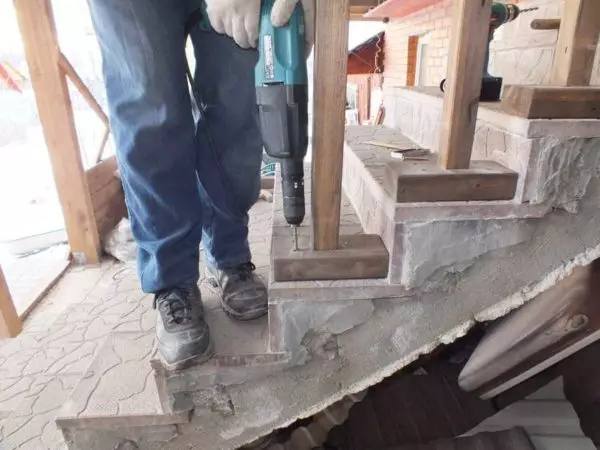
Not the most elegant installation of a balasine of wood on stone or concrete steps, but reliable
In general, a balaasine or pillar is fixed either to the boards of the stage, or to the Kosouro - depends on the design of the stairs. The inner stairs on the cosomra do more infrequently, because, mostly, we will talk about the installation of the railing to steps.
With the help of a bolt (muchahar) to the stage
There is an easy option - through the fastening of balaasine and the support pillars to the stage. The only requirement: the thickness of the stage should be decent - more than 40 mm.
In this case, for the installation of a baluster or pillars in the selected point, the through hole is made through which the bolt with a diameter of at least 8-10 mm is passed (it is possible to 12 and 14 mm depends on the balasine cross section). The minimum shohahar length is 80 mm (the rest can be sprinkled). Under the bolt drills a hole of a larger diameter. After installation, it must be recessed so that the edge of the board remains at least 5 mm. The resulting hole is closed with a decorative lining (you can choose a plastic suitable color or made from wood).
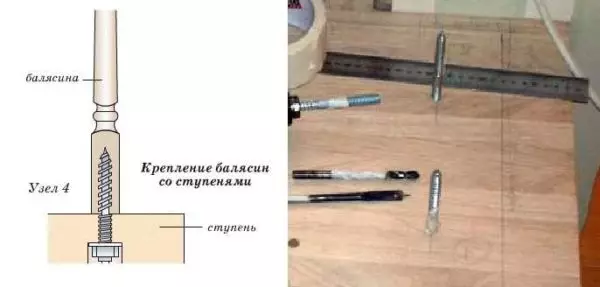
Installing a balaasine of wood: Freak through to the stage
The bolt is inserted into the hole, the hole in the center is drilled by 2-3 mm smaller diameter than the diameter of the bolt used. The specific diameter depends on the wood variety: the harder wood, the less the difference between the drill and bolt diameters should be. The depth of the opening is equal to the length of the bolt.
The bolt is screwed from below, passes through the step, enters the body of the baluster. It is checked on the thread, exhibit. Finally tighten from below using the end key of the desired diameter. The option is good in that, in theory, the connection can be tightened - if you remove the plug and, using the key, reduce the backlash. But the "suspender" works until the hole in the wood becomes too large from the backlash. And he (the backlash) will appear sooner or later - from the loads that are directed in different directions, from the natural processes occurring in the wood. So the connection is not eternal.
On wanking or threaded stud
If it is impossible to get from the bottom, there is an option for fastening a balasine to the wanks (50 * 10, 60 * 12, 70 * 14, 70 * 16 mm). The wankings choose a large, large diameter. Installing a balossine in this case is such: a hole in the step of the depth equal to half the length of the dusting. The second is the same hole drill at the bottom of the baluster. The diameter of the drill is 1-2 mm less than the diameter of the dummy.
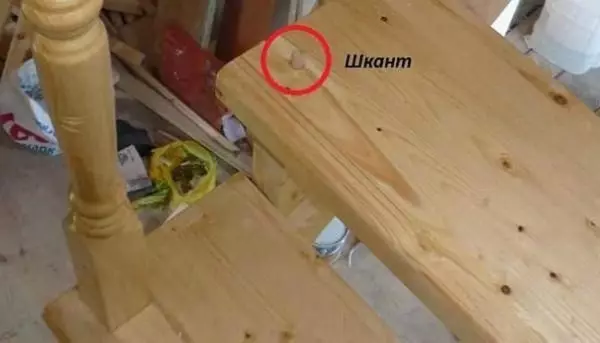
Installation of a railing from a tree on the sewage
Epoxy glue is poured into both holes, the wanking is inserted into the hole in the stage until it stops, then the baluster is put on it. For greater reliability of such mounting with glue, you can wrap the entire lower part of the baluster.
One moment: Looking for the shelter from the same wood from which the steps and railing are made. They have the same thermal expansion coefficient, the equally react to the destruction, increase humidity. This will make the connection more durable. Installation of Balyasin on the sewage - traditional, but not the most reliable way today. Firstly, the specks can break, secondly, the connection itself is still smalleled. So in a few years you will have to look for a way to fix chatting railing.
Instead of the Sucker, you can use a threaded pin. The process of installing the balaasine is no different. All the same, only can be glue without pouring a hole, although ...
On self-tapping
The most "collective farm" method, which is not very fond of professionals, but which is easier to understand and implement - the installation of a baluster on the self-tapping screw. For fastening to steps, tapes for a tree with a diameter of at least 6 mm and a length of 60 mm are used. On each side, they put two (total, for each of 8 screws).
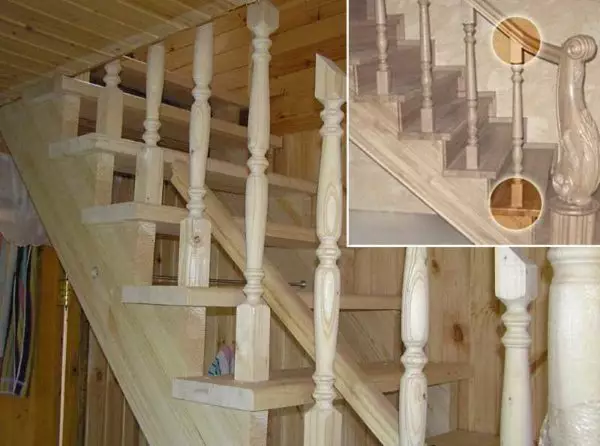
The easiest and most "wrong" way. And also: a lot of troubles in order to close unsightly traces
It is necessary to twist them by half an angle of 30-40 °, under the hats to pre-drill holes. Install the screws, then the holes are closed with plug cut from the same tree or shock with a putty on a tree.
With zipbolt (zipballt)
Relatively new fastener, which can be fixed to steps, and to handrails. It is convenient for use, but it is expensive. If you install the railing with your own hands and "for yourself", this is a good option. Installing a balusne with zipball is good since that the connection can be subsequently tightened by removing the backlash.
Zipballt consists of a threaded stud and removable gear head. There are two types:
- of the two movably connected threaded studs of approximately equal length;
- From one threaded stud (type 13.600).
A variant with movably connected studs is good when connecting a balusne and rail, a railing with support pillars. Direct Zip-bolt is good for a hidden connection of perpendicular bars. Just case the case of the installation of the baluster on the steps, the support pillars on the floor, overlapping the second floor. The dimensions of this fastener are solid - the diameter of 8 mm, the length is 96 mm, so that it will stand it well, and in the reliability of the attachment of the balassine does not have to doubt.
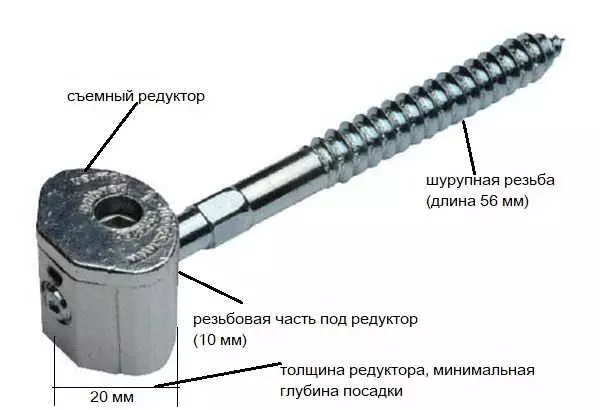
Zipbolt device for perpendicular parts connection
The algorithm itself is similar to the mounting on the heel: it is necessary to drill in the step and the baluster a hole for the installation of the rifle stud. The length of the opening in both parts should be equal to the length of the heel, minus the height of the head.
The difference is that a technological hole is needed to install the head perpendicular to the main one. In size, it should be a little more diameter of the head, and its center must coincide with the axis of the hole under the heel. After the stud is installed, a removable gearbox is inserted into the technological hole. It has special slots on the key. Install the head so that the slots are available. With the help of a hex key of 6 mm, which is inserted into these slots, the head turns to the stop, tightening the baluscin to and fixing the heel.
When installing the reference pillars of the railing on the floor with a zip-bolt, questions may arise according to the fastening method. If the floor is wooden, the threaded part is simply screwed. If the floor is concrete, you can use chemical anchor. If there are metal mortgages, the bolt can be welded. The last way, by the way, the most reliable: even though the bolt will no longer hang out.
Connection "Lastochkin Tail"
Another way to combine balusters and steps is joinery. With the help of the groove and spike of a special shape - a swallow tail. This option is possible if you make balusters yourself or they have a solid stock in length at the bottom.
A similar installation of the BALASIN is possible if the railing is planned to be done almost from the very edge of the steps. Then the holes in the form of a trapezium are cut into steps from the end, the same form on the balusters. The ends of the cuts are lubricated with jointed glue or epoxy resin, combined and fixed.
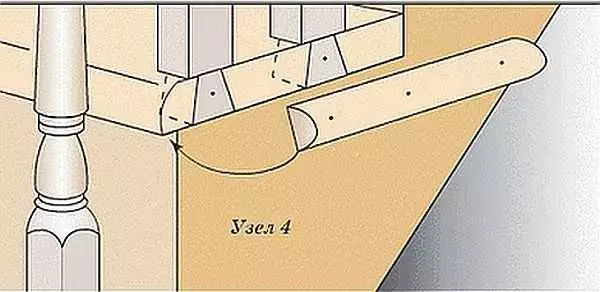
When attaching a "swallow tail", you can still strengthen the connection of the baluster and the steps
With this method of compound, the racks for a while - before drying the glue - it is necessary to fix in a vertical state, as they can deviate. To do this, build a temporary supporting structure that understands the glue through the glue.
To make the steps on the side it looks better, the ends are closed with overhead decorative plars. Planks can be "planted" on glue, nails, self-tapping screws, ducks. The choice is absolutely arbitrarily, but the most correct and inconspicuous is the sewage. A similar installation of BALASIN is based entirely on carpentry art, requires accurate compliance with sizes.
Installation of Balyasin on Kosur (Tutor)
When installing the balaasine on the theater or Kosur, you can use all the same methods of installing the balasine: on the seats, studs, screws, zipballs. You can even make a swallow tail, but it will have to cut it in another plane, which is not harder, but, perhaps, even easier. To decorate, you can use the planks on both sides.
The difference between the BALASIN mounting on Kosur (the tutor) is that the rack must be subspeted at a certain angle so that they stood strictly vertically. But, in the cut at the angle of the surface, it is difficult to drill a hole that goes along the axis of the element. So that there are no problems with these problems, first drill holes, then drink at the desired angle. A simple trick that makes the work is much easier.
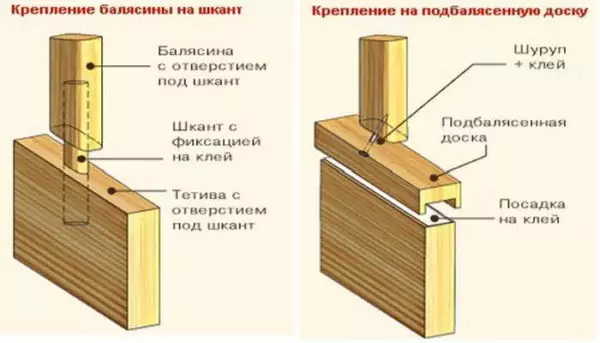
Installation of Balyasin on the Tutor: The process is simple
There is one specifically method calculated on the staircase with a guide. Make a subfalsesennik: a bar, which "sits" on the theettes due to the sinus carved at the bottom. A racks are attached to the sub-bolt, bolts, ducts or self-drawing (worst option). The choice is yours, and then the whole design is installed on the tutor. Connection - adhesive, it is possible to use bots, sammalli, nails for reliability. But they are for additional fixation.
There is another method that usually apply only for this type of stairs: Balasins are fixed with nails or self-drawing, decorative slats are installed from the sides, the gaps between the balusters are closed by locking spacecases. With this method of fixing, you can also additionally use the glue - it will not be superfluous.
A few words about improving reliability
All Balyasin fasteners - on the studs, self-tapping screws, the bolts - over time they are smalleled, the backlash appears. This is an inevitable process. When loading, the railing is slightly risen. At first, the deviation is the share of a millimeter, absolutely invisible. As it uses, the deviation increases, the railing at hand is noticeable "walk". The softer wood, the faster the backlash appears. You have to remove and redo. This is the maximum to delay this moment, use any available additional fixation methods.
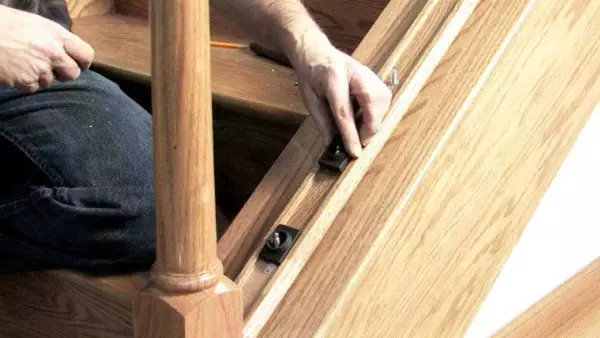
There is a special fastener for balasine on the tutor
Most often, glue uses as an additional fixing force. You can take any joiner or epoxy resin. It makes no sense to look for more expensive - these work very well. Wholes are missing all the docks. You can even lubricate the self-tapping screws / nails. For a better clutch of the place where the glue is applied, purified from dust / garbage, rubbing the bold flare.
Installation of metallic bassine
Installation of balaasine made of metal easier: There are special fixtures - bumps, which are screwed into the steps or to the side of the stairs. The balaasine itself is then fastened to the installed elements, the rack, a pillar. All that is needed is to choose the elements of the appropriate form / size.

Mounting metal balusne to steps is somewhat simpler
There is one point: most of the fasteners proposes to fix balusters in them using clamping screws. So, screws are not very reliable, such a connection quickly begins to "peel". Of course, they can be tightened a couple of times, but much more reliable welding. If it allows the thickness of the metal - from 1 mm and more - it is better to use welding.
Krepim to step
Marking of places of installation of metal balasine occurs as described above. First, we choose one at one rack stand on the step or two, then we distribute them so that all distances are the same. At the outlined places establish tents. They usually "sit down" on 3-4 fasteners. Self-tapping screws, if the steps of wooden or dowels are concrete or brick steps.
Metal balasins / racks are inserted into the installed grooves, are set strictly vertically, welded. "Capture" is better from four sides - to exclude the possibility of deviation in any direction. On this, the installation of a metal of metal (stainless, nickel-plated, chrome steel) is completed. Next only need to install the handrail, which is also not particularly difficult.
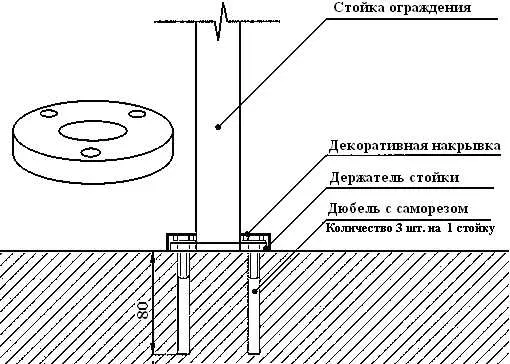
It looks like this as standard fasteners for installing metal balusters of prefab railing.
If the wall thickness of the Tuba of the prefabricated metal rails is too small for welding, it is not possible to choose the appropriate welding mode, it is necessary to secure pipes to the tents using bolts. Clamp, still do not advise. This connection is really quickly cleaned. You can drill through holes in the pipes, screw the suitable diameter bolts into them.
Another option to install a balaasine from the bar: to weld to the bottom of the hairpin, screw into the step. If you wish to the hole in the step, you can glue the nut.
Side (end) Fastening of Balyasin and Pillars
Fastening the racks to steps is a traditional way of installation, but there is another way: to fix it to the sidewall. Similarly, it is possible to mount the railing of any type: wooden, metal, glass. For metal and glass, special fasteners are required - clamps that are attached to the wall, and they themselves have a groove and a system for fixing the struts for the stairs. Wooden pillars and balasins are fasten through the zipball or hairpins / self-pressing, hiding the head under the decorative lids.
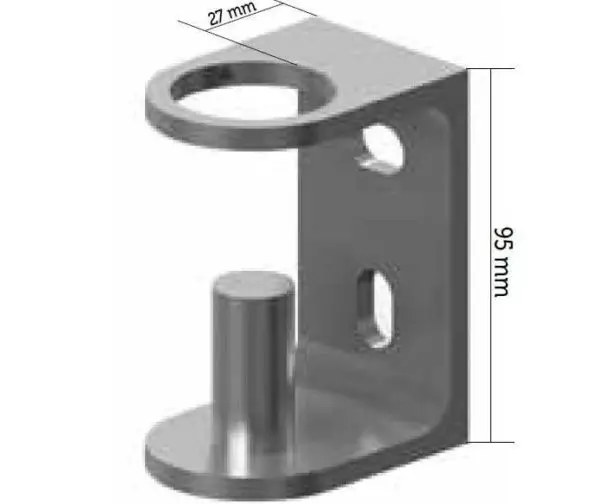
Bracket for lateral fastening of a round reference pillar
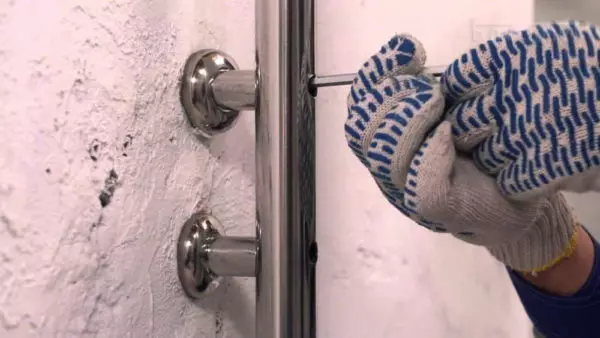
Option for prefabricated metal railing
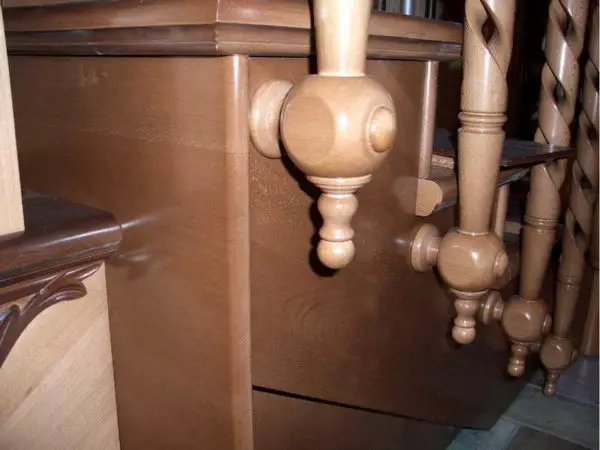
With lateral fastening of wooden pillars on the stairs, the place of attachment can be made in the form of decoration
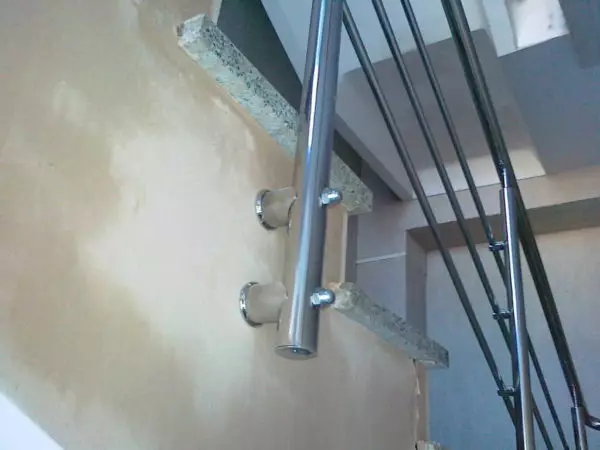
Options are different
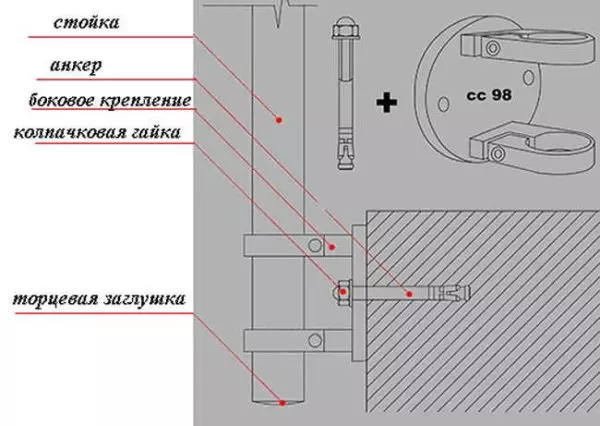
Bracket for fixing round stair racks to the wall
With the end fastening of the racks, the stairs are usually made with support pillars installed after a certain distance. Between the columns, filling, not related to the ladder, but only with support racks. Of course, this is not a rule, but it is precisely such a species that has a majority of stairs with a similar fastening of balusne and support pillars.
The lateral method of fastening passes for any stairs with a closed sidewall. Naturally, the sidewall material must have sufficient carrying ability. The method of fastening the stairs of the stairs looks somewhat unusual, which adds decorativeness.
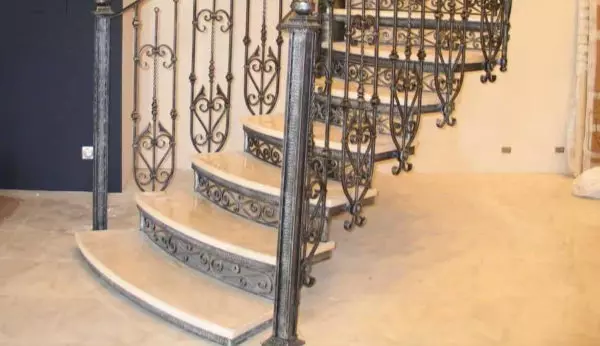
Lateral fastening is possible to steps, but not for all types of stairs
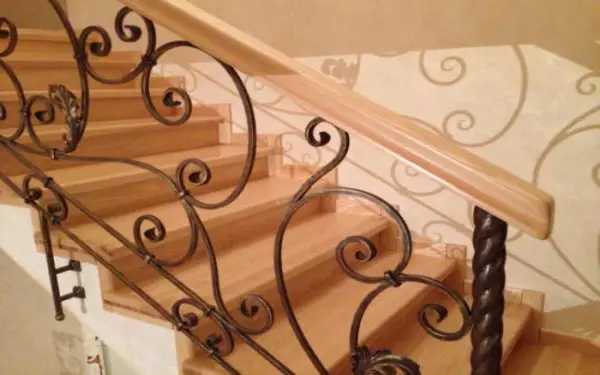
Forged fence for stairs with side mount. Fasteners make immediately "built-in" in the railing
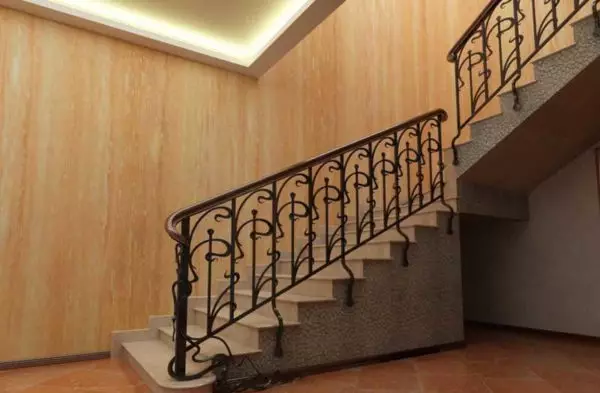
Another option for forged railing with side mount to the stairs
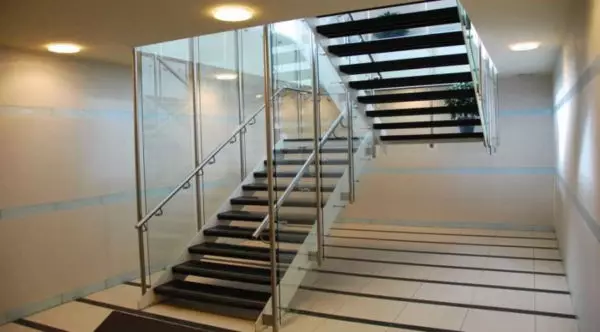
For those who do not suffer from claustrophobia
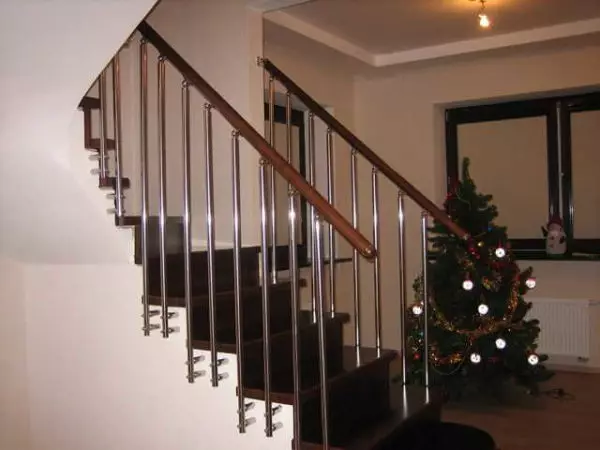
You can fix each rack separately
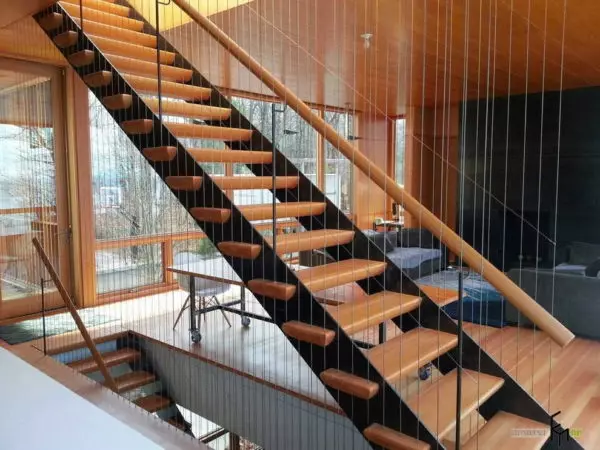
Non-standard approach
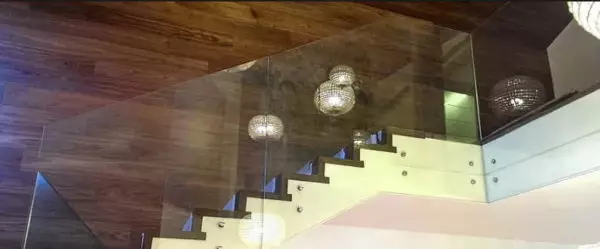
Side fastening of glass railing - on special locks
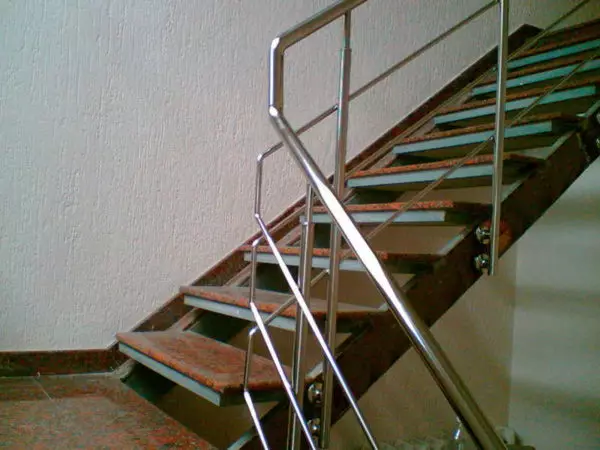
Prefab Metal Staircase with side mount racks to stairs
Usually, each rack uses two locks, which are located at a distance of 5-10 cm one from the other. When markup, you can also use a strained thread, guide or laser level. The location is selected mainly in the center of one of the steps. The number of racks are chosen based on the bearing ability of the base to which they will be screwed. For wood, a normal step is 50-80 cm, for bricks, concrete, etc. You can make long distances.
Article on the topic: Montage Montage Technology
